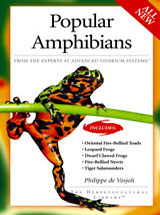Frog Facts: All About Bombina orientalis
 |
One of the most popular frogs in the world is the little gem known as the Oriental fire-bellied toad, a species now imported by the thousands from China and Korea. Its common name, fire-bellied toad, stems from its stout proportions, granular skin, and vivid red belly blotched in black. Fire-bellied toads are ideal for beginners, being tolerant of a range of conditions and feeding on live, commercially bred crickets.
Size: Oriental fire-bellied toads grow up to two inches long.
Lifespan: Captive-bred and captive-raised Oriental fire-bellied toads can live up to sixteen years, and there are claims of individuals living more than twenty years.
Habitat: The Oriental fire-bellied toad lives in the southern part of the Russian Far East, northeastern China, and Korea. Other species of fire-bellied toads live in Europe, North Africa, Russia, China, and northern Vietnam.
Oriental fire-bellied toads sold in the pet trade primarily come from China and Korea. According to importers, the fire-bellied toads collected in northeast China are smaller and less brightly colored than the ones collected and exported from South Korea. Another fire-bellied toad imported from China and incorrectly sold as the “bronze morph” is actually a different species than Bom. orientalis.
Behavior and Adaptations: The vivid orange or red belly coloration of the Oriental fire-bellied toad is considered aposematic, meaning it serves to warn birds and other potential predators of its foul taste and toxicity. When threatened, fire-bellied toads perform an unusual behavior that biologists describe as the Unken reflex. The frogs arch their backs downward and raise the palms and soles of their feet to expose their brightly colored bellies. In some cases, the frogs go one step further and flip upside down to expose their colorful bellies. If turned right side up, the tendency to perform this behavior is sometimes so strong that they flip upside-down again. Amphibians performing the Unken reflex typically produce toxic skin secretions and have bright ventral warning colors.
The Facts: Fire-bellied toads are not true toads. These frogs were recently separated from the disc-tongue frogs (Discoglossidae) and placed in their own family, Bombinatoridae, which includes six species of fire-bellied toads (Bombina spp.) and two species of water toads (Barbourula spp.). Recent work showing a close affiliation of fire-bellied toads to painted frogs (Discoglossus spp.) suggests that inclusion in the family Discoglosside might be valid. In contrast to fire-bellied toads, which are semiterrestrial, water toads are relatively large, completely aquatic and lacking in bright ventral (belly) coloration.
Related Species: Yellow fire-bellied toads (Bom. variegata) are occasionally imported and sporadically available as captive-bred babies. These frogs make attractive displays in shoreline terraria or island terraria with sizeable water sections and are often active during the day. It is quite a sight to see several Yellow fire-bellied toads hanging suspended in the water and exposing their bright yellow and blue-black bellies. These frogs breed easily if cooled into the 40s° F for two to three months during the winter.
Sometimes available as imports or captive-bred animals, the European fire-bellied toad (Bom. bombina) appears similar to the yellow fire-bellied toad, except that it has an orange or red belly. This frog is considered somewhat difficult to breed and requires a cooler hibernation period, as low as 38- 40° F.
The most bizarre and impressive of the fire-bellied toads is the textured, heavily warted giant fire-bellied toad (Bom. maxima) from southwestern China and northern Vietnam. With a dark gray green back and mostly solid red belly, it reaches a length up to 3.5 inches. The giant fire-bellied toad is rarely imported into the United States and even more rarely bred by hobbyists. This frog does best at comfortable room temperatures and has been bred following a period of cooling into the 50s° F.
Excerpt from Popular Amphibians, part of the Advanced Vivarium series with permission from its publisher, BowTie Press, a division of BowTie Inc. Purchase Popular Amphibians here.


